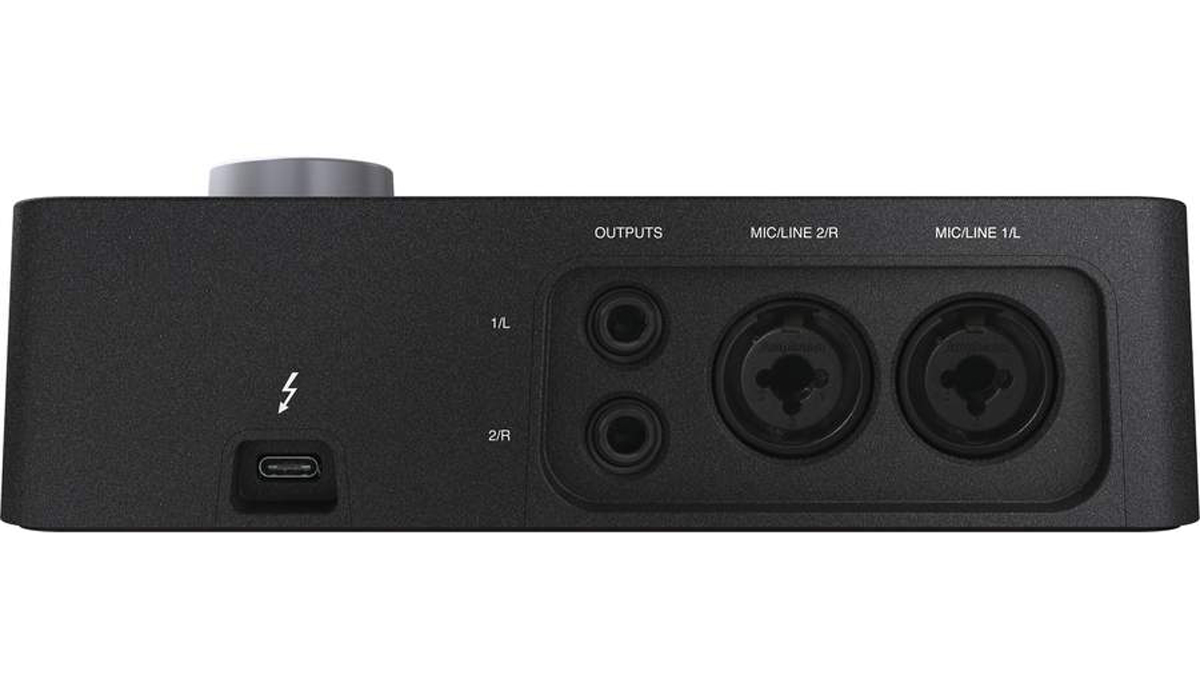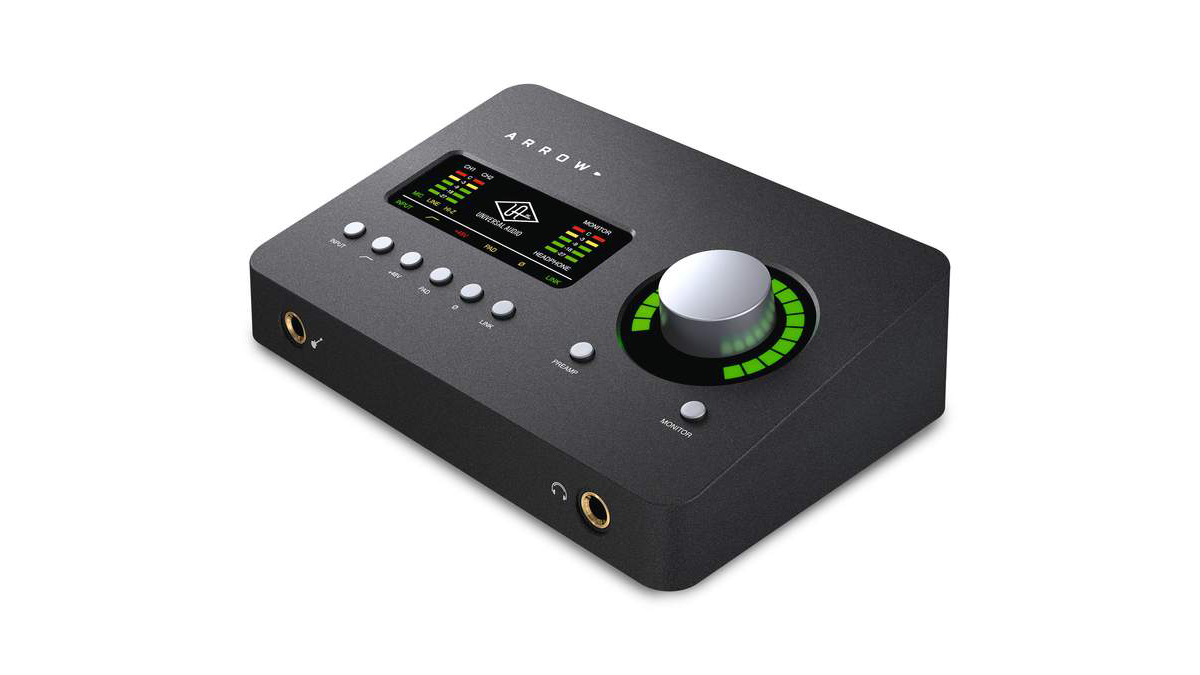MusicRadar Verdict
More than just a cut-down Apollo, Arrow’s bus-powering and form factor make it a genuinely mobile UAD-2/Unison interface.
Pros
- +
A compact, bus-powered UAD-2/ Unison interface at last! Superb sound and workflow.
- +
Solid UAD-2 plugins bundle.
- +
Great price vs Solo Apollo Twin MkII.
Cons
- -
Thunderbolt 3 isn’t ubiquitous.
- -
Thunderbolt 3 cable not included.
MusicRadar's got your back
With their stellar performance and access to the increasingly huge range of superb UAD-2 analogue hardware emulation plugins, Universal Audio’s Apollo audio interfaces are among the music technology industry’s biggest success stories.
However, being externally powered, recording and mixing ‘on the go’ with them has never been an option - until now!
With Arrow, UA is at last offering what essentially amounts to a compact, bus-powered Apollo - no mains plug required. Not only that, but it has also made it its most affordable interface yet, at £140 less than the cheapest Apollo. Consequently, you get a bit less I/O than you do with Apollo, and no Core Duo or Quad DSP options, but, crucially, no compromises have been made when it comes to features and functionality.
There’s a Solo Core chip for powering the 14 included UAD-2 plugins (see Playing the Classics) and any others you might choose to buy, two Unison-enabled mic preamps, and the high quality converters for which Universal Audio are known. In other words, it’s pretty much the full Apollo/UAD-2 experience in a unit you can use anywhere.
Take Aim
As we’ve come to expect from Universal Audio (and, indeed, have every right to in any audio interface at this price point), Arrow is very well built - satisfyingly chunky, with a solid matt metal casing. It’s also nicely compact, with an 18x12cm footprint, and surprisingly light at just 0.63kg. Eminently portable, then.
Arrow is a Thunderbolt 3 device - the first of its kind, in fact. Thunderbolt 3 uses the same connector type as USB-C but isn’t the same thing, so potential Arrow owners should make sure that what appears to be the right port on their computer isn’t in fact USB-C. For Mac users, this is very straightforward: the current generation of MacBook Pro, iMac and iMac Pro include compatible Thunderbolt 3/USB-C ports, but the 12" MacBook’s identical-looking hole is only USB-C and thus won’t work with Arrow.
For PC users, the situation is less clear cut, of course, but there are now quite a few Thunderbolt 3-packing machines on the market, so just be very clear on your specs before you buy.
Want all the hottest music and gear news, reviews, deals, features and more, direct to your inbox? Sign up here.

The stated reason for the use of Thunderbolt 3 rather than 1 or 2 is that it enables the bus powering that’s key to Arrow’s portability. The data transfer side of things is fully backwards compatible all the way back to Thunderbolt 1, however, so you could use an externally powered Thunderbolt 3 dock to connect Arrow to a Thunderbolt 1/2 computer.
Naturally, though, UA point out that this particular setup isn’t fully tested or officially supported. Plus, of course, mobility is one of Arrow’s big selling points, so if you’re going to lumber yourself with a power supply and dock, it might be worth stepping up to the Core Solo Apollo Twin MkII anyway.
The other consideration is the cable used to plug Arrow into the computer. Disappointingly, there isn’t one in the box, so you have to buy one separately, and again, it has to be specifically made for Thunderbolt 3 - USB-C won’t work.
Target practice
For I/O, Arrow has two XLR/1/4" combi mic/line inputs, a Hi-Z guitar input (superseding mic/line input 1 when connected), two 1/4" balanced line outs and a 1/4" headphone out. What you lose in comparison to Apollo, then, is a pair of additional line outs and the eight-channel ADAT optical input.
Workflow-wise, Arrow is identical to Apollo. Dedicated top-panel buttons switch the knob between controlling preamp input and monitoring output levels, and operate input selection, a high-pass filter, 48V phantom power, a 20dB pad, polarity inversion and stereo linking. The display area provides simple metering and function indicators, and pressing the knob launches Gain Stage Mode, for hands-on control of Unison plugins.
First-class audio interfacing aside, as with Apollo, the real draw with Arrow is its ability to power Universal Audio’s UAD-2 plugins (VST/AU/AAX/RTAS) for low-latency (in Console) monitoring and tracking. The UAD-2 line-up comprises a comprehensive roster of astonishingly realistic classic hardware emulations, the same 14 of which are included with Arrow as with Apollo.
Called the Realtime Analog Classics Bundle, this tidy collection features the Legacy (but still great) versions of UA’s Teletronix LA-2A Classic Levelling Amplifier, 1176SE/LN Classic Limiting Amplifiers and Pultec Pro Equalizers, as well as the Marshall Plexi Classic Amplifier, 610-B Tube Preamp and EQ, Raw Distortion and more. The 610-B, Marshall Plexi Classic and Raw are Unison-friendly, too. Needless to say, Arrow is also compatible with the entire vast and ever-expanding UAD-2 plugins catalogue
With the Core Solo chip only able to run a handful of more recent UAD-2 plugins at once (the Marshall Plexi Classic hits 30% on the DSP meter, for example), you won’t be processing an entire mix in real-time with Arrow. However, there’s more than enough juice in the tank to put together a complete monitoring and/or recording chain for your vocal mic and guitar.
UA’s excellent Console software hooks into Arrow for near-zero-latency mixing and monitoring with UAD-2 plugins, and loading compatible plugins into the two Unison preamps. Unison is UA’s breakthrough technology, reconfiguring the actual impedance, gain staging and other physical properties of the preamps for authentic emulation of both the sound and ‘feel’ of classic preamps, channel strips and guitar amplifiers. For guitarists and singers, this on its own could well make Arrow (or Apollo) nothing short of a must-have.
Away from Console, audio interface performance is as expected, with round trip (ie, input plus output) latency in Ableton Live of 10.2ms at 64 samples and 30.5ms at 512 samples. And most importantly, UA’s AD converters deliver the goods as always - without Unison processing, Arrow sounds absolutely pristine; with it, all manner of gorgeous analogue colouration is on the cards.
The mighty Arrow
Well, UA has finally done it: Arrow is the mobile Apollo we’ve all been waiting for. Sure, Thunderbolt 3 might rule it out, depending on your setup; that Solo Core DSP quickly runs out of steam; and, like any heavy-draw bus-powered peripheral, it puts the serious smackdown on your laptop battery.
But none of that detracts significantly from the - for many - game changing ability to take your UAD-2 plugins, complete with glorious Unison preamps, on the road. A truly amazing thing.
Computer Music magazine is the world’s best selling publication dedicated solely to making great music with your Mac or PC computer. Each issue it brings its lucky readers the best in cutting-edge tutorials, need-to-know, expert software reviews and even all the tools you actually need to make great music today, courtesy of our legendary CM Plugin Suite.

